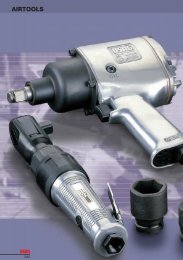Industrial seal self study guide - SKF.com
Industrial seal self study guide - SKF.com
Industrial seal self study guide - SKF.com
You also want an ePaper? Increase the reach of your titles
YUMPU automatically turns print PDFs into web optimized ePapers that Google loves.
With the <strong>seal</strong> removed, check for:<br />
• Rough bore surface.<br />
• Shaft cleanliness (is it clean and free of carbon?)<br />
• Coked lube on the shaft.<br />
• Shaft damage.<br />
• Flaws or voids in the bore.<br />
• Shaft corrosion.<br />
• Shaft discoloration.<br />
Identify the <strong>seal</strong> style and materials. Then inspect it for:<br />
• Primary lip wear.<br />
• Primary lip conditions.<br />
• Seal O.D. wear/damage.<br />
• Spring damage.<br />
Proper Seal Measurement<br />
Two of a <strong>seal</strong>’s measurements are its outer diameter (O.D.) and its<br />
inner diameter (I.D.). To determine these, follow these procedures:<br />
• To measure the O.D. of a <strong>seal</strong>, take three measurements equally<br />
spaced around the outside of the <strong>seal</strong>. The average of the three is<br />
the <strong>seal</strong>’s O.D (fig. 9b).<br />
• A metal O.D. <strong>seal</strong> is generally 0.005 to 0.016 inches (0. 13mm<br />
to 0.41mm) larger than the bore, for press fit.<br />
• A rubber O.D. <strong>seal</strong> is generally 0.008 to 0.020 inches (0.20mm<br />
to 0.51mm) larger than the bore, for proper <strong>com</strong>pression and<br />
interference fit.<br />
The average of three measurements<br />
around the outside of the <strong>seal</strong> is the<br />
<strong>seal</strong> O.D. (fig. 9b).<br />
9<br />
• The inner diameter is more difficult to measure. Take about five<br />
I.D. readings, average them and add an interference figure to the lip<br />
I.D. to reach the approximate shaft I.D. (see Catalog 457010).<br />
• Alternatively, use the shaft O.D. as the <strong>seal</strong> I.D. Then refer to size<br />
listings in the <strong>SKF</strong> Handbook of Seals, for determining the correct<br />
<strong>seal</strong> part number.<br />
Common Sealing Problems<br />
Common <strong>seal</strong>ing problems, their causes and solutions, are detailed<br />
below.<br />
Hammer Damage<br />
Some obvious signs of hammer damage include visible dents on the<br />
<strong>seal</strong> back, a distorted <strong>seal</strong>ing element, or a garter spring that pops out<br />
(fig. 9c).<br />
Visible dents on the <strong>seal</strong> back are<br />
symptoms of hammer damage (fig. 9c).<br />
79







